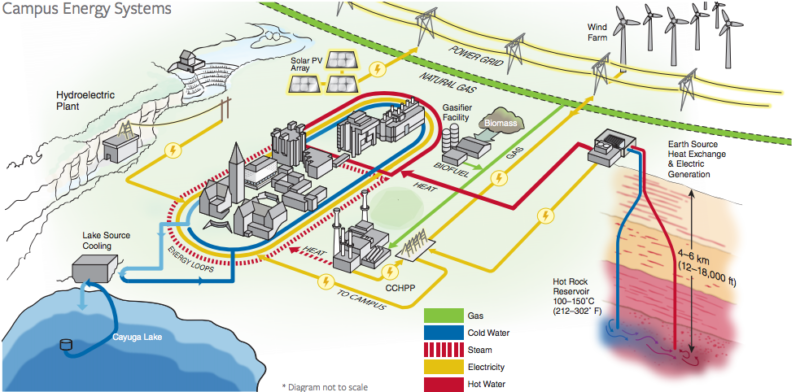
Cornell University
Geothermal energy—energy drawn from the internal heat of the Earth—has long been the purview of mountainous, volcano- and earthquake-prone regions like the western United States or Iceland. The US’ eastern states, on the other hand, have been generally disregarded as geologically unfit for geothermal projects because the rock beneath them rarely has the natural fractures or water sources necessary to easily build a geothermal system. But that’s not stopping Cornell University, based in upstate New York, from thinking it can warm its Ithaca campus in winter by tapping into heat from “basement rock,” two to four miles underground.
Cornell announced a new project, called “Earth Source Heat,” this month. The university will research and potentially execute a system that will involve drilling deep into the rock near the campus, circulating fluid to capture the naturally occurring underground heat, and using that fluid to directly heat the campus (rather than change the heat into electricity, as many geothermal plants do).
The project would be considered an “enhanced geothermal system,” or an EGS, which differs from a regular geothermal system in that the reservoir of hot rock into which fluid is injected is man-made, rather than naturally created. EGS projects have been very limited in the US. In 2014, when Ars toured a geothermal plant outside of Reno, Nevada, Karl Gawell, the executive director of the Geothermal Energy Association, called EGS a "tough business" because funding for projects was difficult to come by, and private companies found such an endeavor far too expensive to be economically feasible.
But Cornell wants to change that. “A recent survey of the upper Appalachian basin conducted by Cornell Engineering revealed that subsurface heat deep in portions of New York and Pennsylvania is likely of sufficient quality to provide district heating to residential and commercial buildings,” the university wrote in a press release. “This is especially significant given the Northeast’s cold winters and dense population centers.” If Earth Source Heat is successful, it could light the way for other institutions to develop a similar heating system.
Because of Ithaca’s cold winters, Cornell expects to supplement the EGS with heat from biofuel made from wood or non-food crops. The biofuel component would only kick in during times of peak load.
The grand vision for Earth Source Heat is not a guarantee, however. Cornell will start with a demonstration project, which will include building two wells, as well as heat-exchange technology, to heat targeted areas of the campus. A Cornell spokesperson told Ars that such a small-scale demonstration would likely cost $12 million to 15 million in initial research. Currently, the university is trying to build support among community members and assemble researchers and investors from higher education, private business, and government agencies. If the demonstration is successful, then the university will move toward a “full-scale geothermal project.”
Ars e-mailed Gawell for his opinion on the enhanced geothermal project proposal. In his response, he told Ars that he had high hopes for Cornell's project. “It's exciting to see their sense of investing in the future, and I'm sure given their location their heating needs must be substantial. Like many renewable technology ventures, it may cost more upfront but will pay dividends for decades.”
“The project will also make Cornell a technology leader,” he added. “There are a number of schools and universities using geothermal. Oregon Institute of Technology uses higher temperature geothermal for heating and power on campus, Ball State University uses geothermal heat pumps to heat buildings across its campus, but Cornell is the first to propose combining EGS techniques for heating in the Eastern US.”
Clearly, there are a lot of hurdles to clear here; even if Cornell clears them, EGS heating of the whole university will be years, if not decades, away. But the project is more than just pie-in-the-sky dreaming, too, because Cornell has done similar upgrades for cooling. In 1998, the New York State Department of Environmental Conservation approved the university’s Lake Source Cooling project, which uses chilled water from nearby Cayuga Lake to provide cooling to the campus. The project cost the university $58.5 million, but since 2000, it has saved the campus 25,000,000 kWh per year in cooling and allowed Cornell to eliminate refrigeration equipment that contained chlorofluorocarbons (CFCs) and needed to be replaced.
The EGS plan comes at a time when Cornell is still trying to figure out ways to reduce its carbon footprint to meet a self-imposed emissions reduction goal that the university committed to in 2009. “Since that time, Cornell has reduced its emissions by more than 30 percent through several initiatives, including the construction of solar farms and the decommissioning of its coal-powered energy plant,” the university’s press release stated. “Cornell is pursuing the Earth Source Heat project to eliminate up to an additional 38 percent of its emissions.”
"Cornell cannot reach climate neutrality without eliminating the fossil fuels that are used to heat campus, and there are very few potential technologies (utilizing the resources we have here in Ithaca) to do so," the university wrote in an informational sheet. At the moment, renewable geothermal energy might be the school’s most economical path to such dramatic reductions in carbon output.